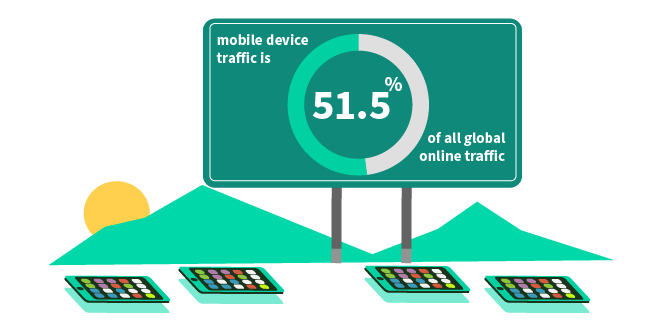Having mobile optimised content is more important than ever.
Did you know that on average people are spending 5 hours a day on their smartphones?
With a typical 24-hour day being easily divided into 8 hours of sleep and then 8 hours of work, that only leaves 8 hours left of free time. And with 5 of those spent on our phones, it’s evident that mobile has become a huge part of our everyday lives.
But what are we actually doing on our phones? And before you think it, no – we are not spending all this time on TikTok. We’re actually shopping.
According to research, 67% of consumers admit to “digital window shopping” for fun on their smartphones, with 77% of those making impulse purchases when they do.

In fact, 70% of mobile searches lead to action within an hour. For comparison, it takes desktop users a full month to reach the same percentage.
With access to information at just a few clicks of a button, the impulsiveness to purchase products makes mobile phone searches very lucrative. It opens up plenty of avenues for marketers to reach an even wider audience.
We know that traditional content marketing is a great way to reach new audiences. And 69% of smartphone users say they are more likely to buy from companies whose mobile sites or apps help them easily find answers to their questions. So, it’s clear that having mobile optimised content that can be easily consumed via smartphones is a must for brands.
No longer is it safe to assume that searchers are going to be accessing your website using a traditional desktop computer. There’s a good chance they’ll be coming through a smartphone or tablet device.
What is Mobile Optimisation?
Mobile optimisation is the process of tweaking your website’s content to ensure that visitors who access that site from mobile and other small tablet devices have a smooth user journey.
The transition from desktop to mobile devices should provide the user with a quality and easy experience. Mobile devices are much smaller and often used when on-the-go.

Therefore, optimised content needs to automatically adjust to fit on these devices, only show content which is compatible with mobile devices, have fast loading speeds, and be easy to navigate.
Why Your Content Needs to Be Mobile Optimised
Mobile phone usage has grown insurmountably over the past few years, and the number of consumers using web searches to make informed purchases is growing even higher.
For brands, this seems like an obvious reason to make their web content more accessible to searchers.
But there are a few other reasons why mobile optimised content is hugely important. We’re going to cover them in detail below.
Mobile Searches are Surging
As already mentioned, the way consumers access content is changing. With a rise in smartphone users, the demand for mobile-friendly websites is increasing. No longer are desktops the main way in which people are looking for information or to purchase a product.
In fact, research has found that mobile device traffic accounts for over half of all global online traffic (51.5%).

Cast your mind to the last time you did a Google search on a desktop computer or laptop. Why were you searching on that particular device?
Was it because you were at work, looking for answers to help you with a project? Perhaps you were sneaking in a quick search of what ingredients you need to pick up on your way home.
Was the search done purely because the desktop was conveniently sat in front of you?
Now think about when you last did a search on your mobile. Was it today? To check the weather? Quickly catch the football scores? Or perhaps you ran out of toothpaste and needed a quick next day delivery purchase.
Whenever we’re in need of a quick answer to or to complete a speedy transaction, we seek convenience. It’s easier to reach into our pockets and pull out our mobile phones than load up our computers.
With the power of 4G & 5G networks and speedy browsing speeds, mobile searches can be done almost anywhere at any time. No longer do we need to load up the desktop and Ask Jeeves – because we have mobiles.

And it’s this convenience which is moving our digital world further away from traditional desktop searches.
Almost everyone is using mobile to search for things. So, if you’re a brand without a mobile web presence, you’re missing opportunities to connect with more searchers.
Mobile-Optimised Content Leads to Higher Rankings
As the demand for mobile-friendly content surges, search engines have worked hard to better connect searches to those sites which will work across all device types.
In fact, with 65% of clicks on Google Ads coming from mobile devices, it’s hardly surprising that Google wants to optimise the mobile experience for searchers.
Over the past few years, Google’s algorithm updates have focused on creating a mobile-first index. This is where the search engine prioritises the use of mobile websites over desktop-only versions.

This doesn’t mean that desktop-only sites can’t be included in the index. But, as the name suggests, those with a mobile optimised site may rank above those who do not.
As Google shift towards creating better experiences for mobile users, brands need to optimise their content for mobile. If they want to be in with a chance of ranking highly, it’s a necessity.
And it’s a no brainer. If you want to have any success with your SEO, you have to ensure your website is properly optimised. As well as being accessible to all devices.
Mobile Searches are More Commercial
Today’s shoppers are savvier than they ever have been. They want to know exactly who they’re spending their money with and whether it’s a good investment.
With all the information available to them through the internet, many are taking the time to investigate before buying. They will likely research a product or service before they place their purchase.
And for a while now, Google has found that lots of this research is happening on mobile devices.
According to them, over a two-year period, mobile searches for ‘best’ grew over 80%. And, product review searches increased by 35%. As for content, videos which contain the word ‘review’ in their title ran up over 5000 years’ worth of watch time!

With the surge in mobile shoppers rising, it’s no surprise that research prior to transactions is on the rise too.
When it comes to seeking advice, search engines can offer users really specific and detailed information on almost anything in the world. Websites are active 24/7. This allows brands to offer virtual guidance all-day long to people looking to make guided purchases.
It’s imperative that you optimise your website’s content for mobile users. Especially with an increasing number of commercial searches taking place on mobile. Ensure your website is at the top of those search engine results pages for them to take information from.
If you’re the source that answers your searcher’s query, they’ll view you as an authority on the matter. As such, they’ll keep coming back to you for further queries. Then, when making a purchase in the future, you’ll be in their mind as the brand to purchase from.
Mobile Optimisation Improves the User Experience
One of the most important reasons for creating mobile optimised content is to improve the user experience.
The whole premise of content marketing is to offer relevant, engaging and quality information that satisfies a user-search query. In other words, it’s to offer the best possible online experience for that user.
But there’s no point having quality content on your website if users have trouble accessing or navigating through it.
And this is why optimising your website’s content is so important.

There are multiple issues that may cause site users to bounce. If the text is too small for the screen. Pop ups overshadow your content. Or the user can’t click through to a related article.
It’s no surprise your site visitors don’t stick around very long.
And don’t forget, this lack of time spent on your webpage could be harmful to your rankings.
By creating a mobile presence which is both fun and easy to navigate, you’ll be solidifying the user’s experience. Thus, encouraging them to come back to your website in the future.
You’ll be spending less on trying to drive new leads to your site. And can improve the customer lifetime value of those who have already purchased something with you previously.
Mobile Optimisation Helps you Remain Relevant
If having a mobile-responsive website isn’t a top priority for you then beware. This is because chances are your top competitors have probably already made sure their site is.

Going back to Google’s mobile-first index, we know that search engines are beginning to prioritise mobile optimised websites in rankings. So, if your competitor has their website properly optimised and you haven’t, chances are they are probably ranking higher than you.
In addition to this, your bounce rate is likely higher. If a user were to land on your website and suffer the consequences of an unresponsive design, they’re probably going to bounce.
If they then land on your competitor who offers easy-to-navigate and high-quality content, you can probably guess which site they’re going to return to in the future and spend their cash with.
So, if you want to remain the most relevant industry leader, ensure your website is optimised to suit modern consumers.
Summary: Making Your Content Mobile-Friendly for Long-Term Growth
The modern demands of consumers have made content an increasingly popular marketing channel for brands. Consumers continue to research and make informed decisions about their purchases. As such, this creates plenty of opportunity for brands to forge connections. The best way to do this is by creating content that adds value to these searchers.
But, with the surge of smartphone users changing the way in which we access this content, mobile optimisation is important. In fact, it’s crucial for brands to ensure their websites are properly optimised for mobile.
Mobile searches have become so popular that Google has even rolled out a mobile-first index. This prioritises mobile-optimised websites over desktop-only sites. For brands this is huge. If you want to rank highly in SERPs and be more discoverable to relevant searchers, you need mobile optimised content.
Making your content mobile-friendly isn’t just about making your content more discoverable for searchers. It also makes their entire experience far more enjoyable and ultimately, engaging. If your content is properly optimised to benefit their time on your site, expect to see more people returning.
Optimising your Website With a Marketing Consultant
We’ve seen in this article the importance of optimising your website for mobile users. But that’s not the only steps you should be taking if you want to create long-term growth for your business.
Content marketing is a much more complex strategy than simply improving a mobile users’ experience. It’s a time-consuming, richly detailed process. It involves researching and creating media that addresses your searcher’s queries and helps to guide their future purchasing decisions.
Often, brands turn to marketing consultants like myself to help grow their website. Usually because they don’t have the time or resources needed to make their SEO strategy a success.
If you’re looking for help to drive more traffic to your website and improve your conversion rate, why not get in touch with my team? With over 30 years’ experience working with clients to grow their businesses, we know exactly what it takes to drive the growth you need to excel online.







